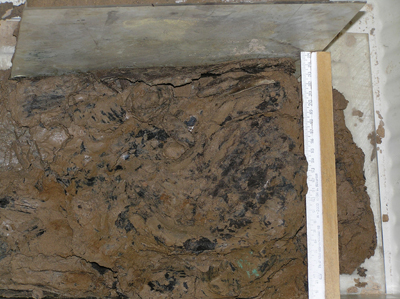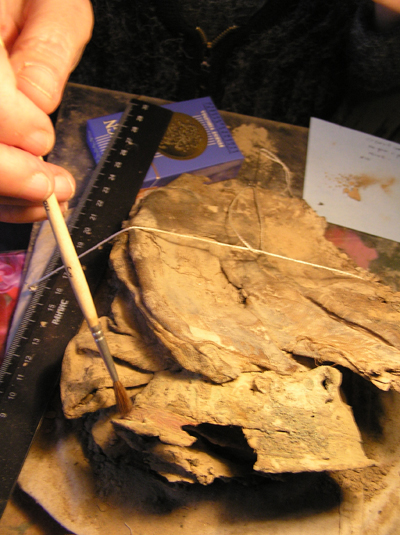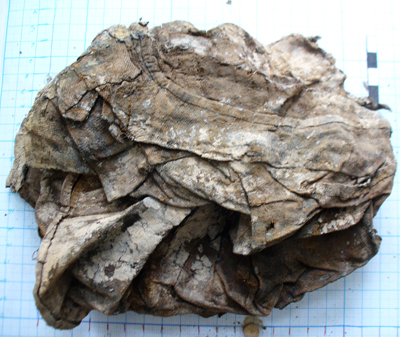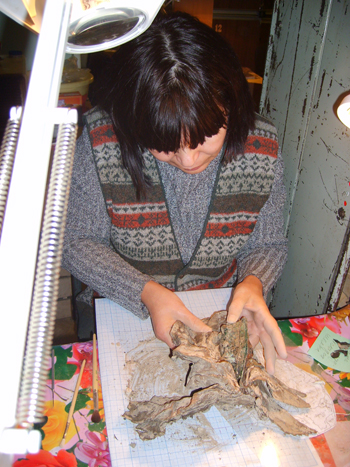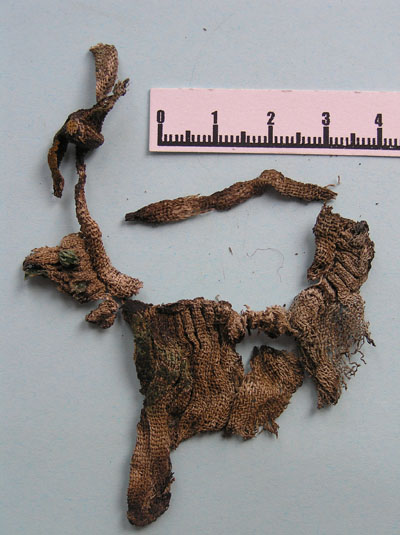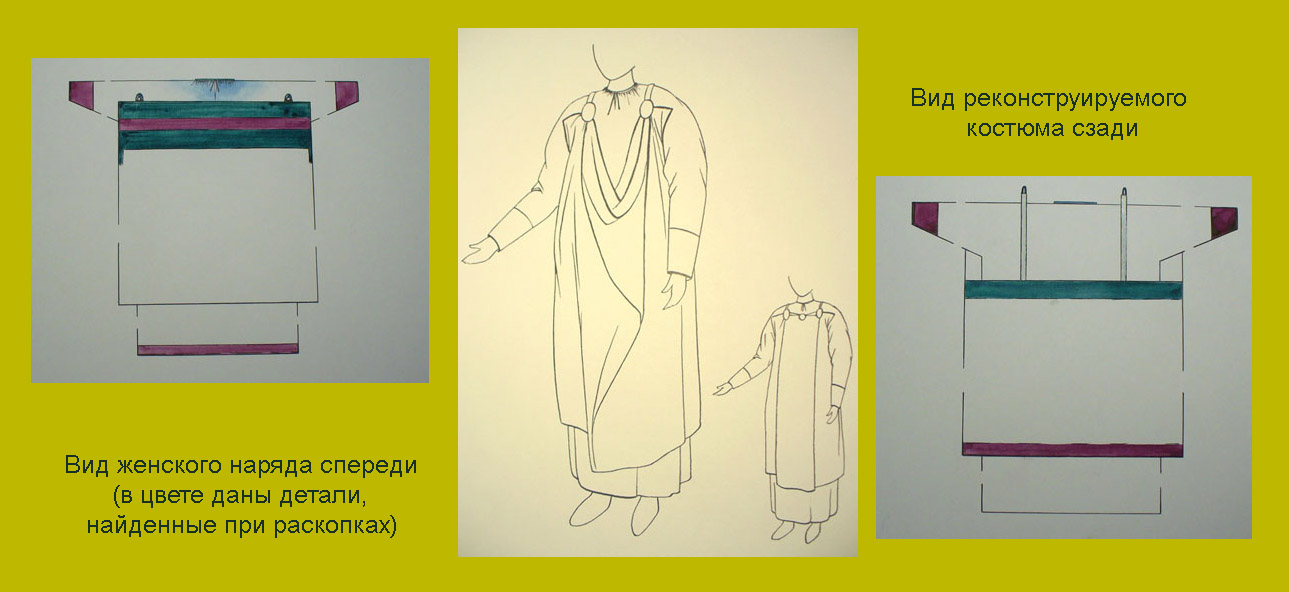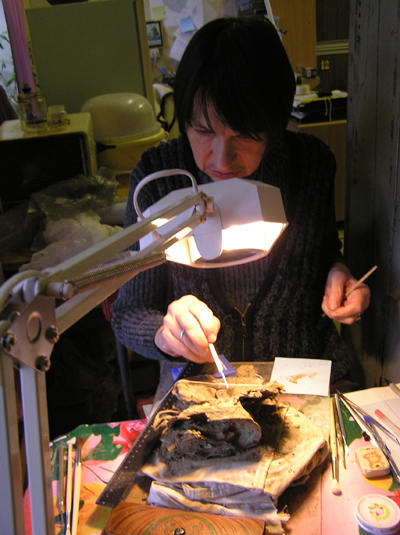
Fabric Treasure
by E. Zubkova, O. Orfinskaya, D.S. Likhacheva.
found on Pskov Archeological Center Website
Updated 29 July 2007
The original Russian article. - Link broken as of 3/2013.
Peter Beatson's excellent summary.
[Translator's Note: As usual, items in brackets are my comments and parentheses are from the original document .]
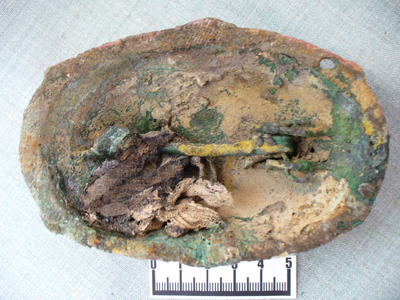 To receive a large fragment of ancient fabric - for archeologists in any situation is a gift! After all fabric in the earth is practically not preserved, especially in our relatively dry Pskov layers. But the special significance of the find was appreciated by scientists only after detailed investigation of each preserved little piece.
To receive a large fragment of ancient fabric - for archeologists in any situation is a gift! After all fabric in the earth is practically not preserved, especially in our relatively dry Pskov layers. But the special significance of the find was appreciated by scientists only after detailed investigation of each preserved little piece.
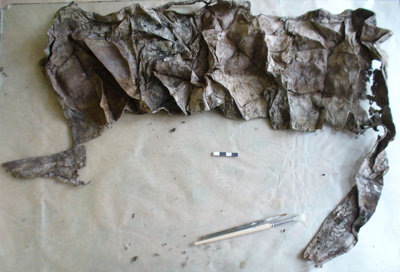 The largest fragment is this piece of ornament of the upper part of a sarafan. It's wide part was sewn on in front - on the chest, while the narrow lateral strips decorated the sarafan along the upper edge of the armhole and back. The name "sarafan" should be considered provisional, used for convenience of description. But that this uncovered garment actually most of all resembles a sarafan, witnesses the remains of a strap on one of the sides of the front and back part of the piece.
The largest fragment is this piece of ornament of the upper part of a sarafan. It's wide part was sewn on in front - on the chest, while the narrow lateral strips decorated the sarafan along the upper edge of the armhole and back. The name "sarafan" should be considered provisional, used for convenience of description. But that this uncovered garment actually most of all resembles a sarafan, witnesses the remains of a strap on one of the sides of the front and back part of the piece.
 The sarafan was worn over a fine long linen rubakha. In front at the throat was a small slit, the upper edge of the collar was placed fine gathers and trimmed with a rolled hem of the same fabric. The long ends of the rolled hem tighted the edge of the slit. The sleeves of the rubakha were long and decorated with a superimposed cuffs of red silk. Narrow strips of such red silk decorated also the hem of the rubakha. Both the sarafan and the rubakha were sewn of linen fabric, dyed a blue color. Linen fabric almost completely decays in the ground. Have managed to carry away and preserve only small fragments of various details: collar, strap, and loop.
The sarafan was worn over a fine long linen rubakha. In front at the throat was a small slit, the upper edge of the collar was placed fine gathers and trimmed with a rolled hem of the same fabric. The long ends of the rolled hem tighted the edge of the slit. The sleeves of the rubakha were long and decorated with a superimposed cuffs of red silk. Narrow strips of such red silk decorated also the hem of the rubakha. Both the sarafan and the rubakha were sewn of linen fabric, dyed a blue color. Linen fabric almost completely decays in the ground. Have managed to carry away and preserve only small fragments of various details: collar, strap, and loop.
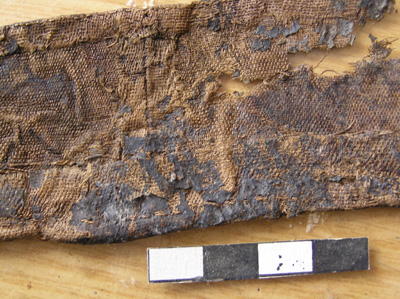
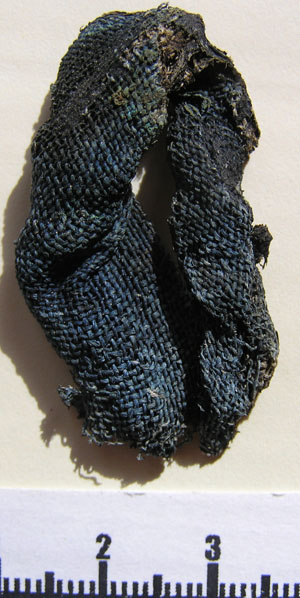 But modern methods of investigation allow to define both the type of fabric and its color. Instead of buttons the straps of the sarafan were fastened with fibuli, and so that their rather massive pins did not damage the fine fabric, to the ends of the straps were sewn loops of linen fabric, through which passed the needles of the fibuli.
But modern methods of investigation allow to define both the type of fabric and its color. Instead of buttons the straps of the sarafan were fastened with fibuli, and so that their rather massive pins did not damage the fine fabric, to the ends of the straps were sewn loops of linen fabric, through which passed the needles of the fibuli.
In such a way, relying on already known reconstructions of ancient women's clothing and starting from the rich factual material, which for the first time found itself in the hands of Pskov archeologists, managed to establish the outward appearance of the apparel. One must note also that both the srafan and rubakha were neatly rolled and placed in a birchbark basket/box (evidently, covered with a leather lid. Its remains were discovered in clearing the soil monolith) which the relatives of the deceased put away under the floor of the grave chamber in the expectation that this would be useful to her in the afterlife.
Authors of the article - E. Zubkova, senior scientific associate of the Pskov Museum-Preserve, archeologist, restorer, O. Orfinskaya, scientific associate of the Institute of culture and natural heritage im. [?] D.S. Likhacheva, k.i.n. [?] expert in fabrics.
From the editor: about the amazing silk-fabric pattern on fabric of the 10th century our authors with relate to you in their next article... [!]
Translation COPYRIGHT (c) 2007 by Lisa Kies. Photos used by permission of the Pskov Archeological Center. You may make copies for personal use and to distribute for educational purposes but only if the article remains complete and entire with original authorship clearly noted.
Return to Russian Materials.

